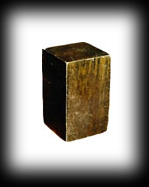History of the CajónThe cajón is believed to have originated in Peru. African slaves displaced from their homeland substituted cod shipping crates for their native drums. In Cuba, small dresser drawers were used for the same purpose. The instrument was refined and became an important part of Cuban and Peruvian music.Three quarter inch pine or other white wood was generally used for five sides of the box. A thin sheet of plywood was nailed on as the sixth side and acted as the head or striking surface. The top edges were often left unattached and could be slapped against the box. A sound hole was cut in the side opposing the head. The player sat on the box striking the head between his legs. Today, the cajón is heard extensively in Afro-Peruvian, Andean, Cuban, and Flamenco music. It's steadily gaining popularity in all types of contemporary music and has become a favorite for acoustic or "unplugged" sessions. The instrument has evolved considerably from it's origins as a discarded wooden box. Cajónes are now built from a variety of different woods in various shapes and sizes. The "Flamenco" style of adding wires has taken hold and many cajónes now feature a "snare" type buzz. Recently, cajons made from synthetic materials have joined the ranks of mass produced instruments. |
| © Michael Kotzen 1997-2025 |

The ToneCajón™ |
History of the Cajón |
Marimbula |
In Session |
Gallery |
Press |
Contact |
Available Cajons |
Apparel
